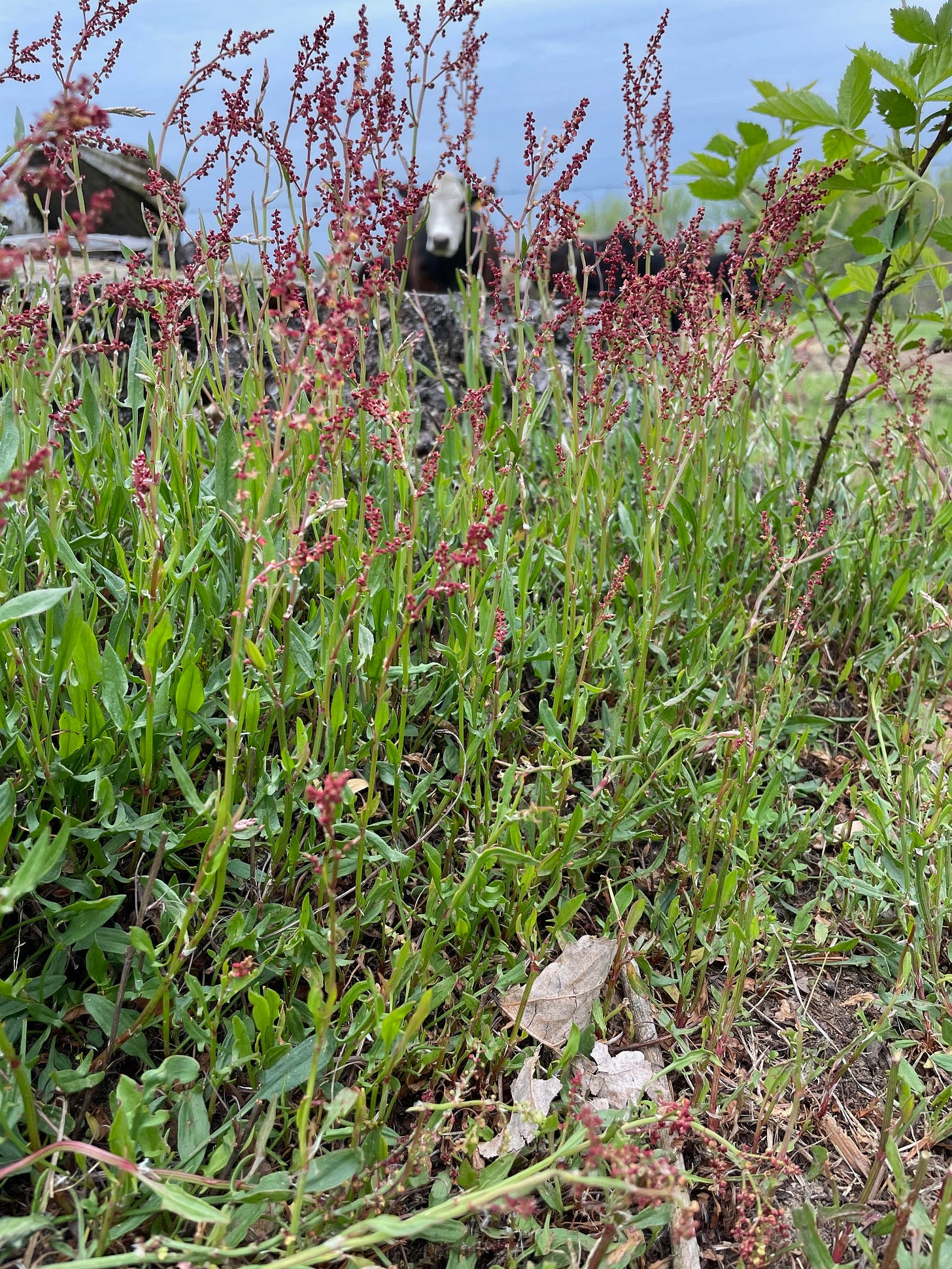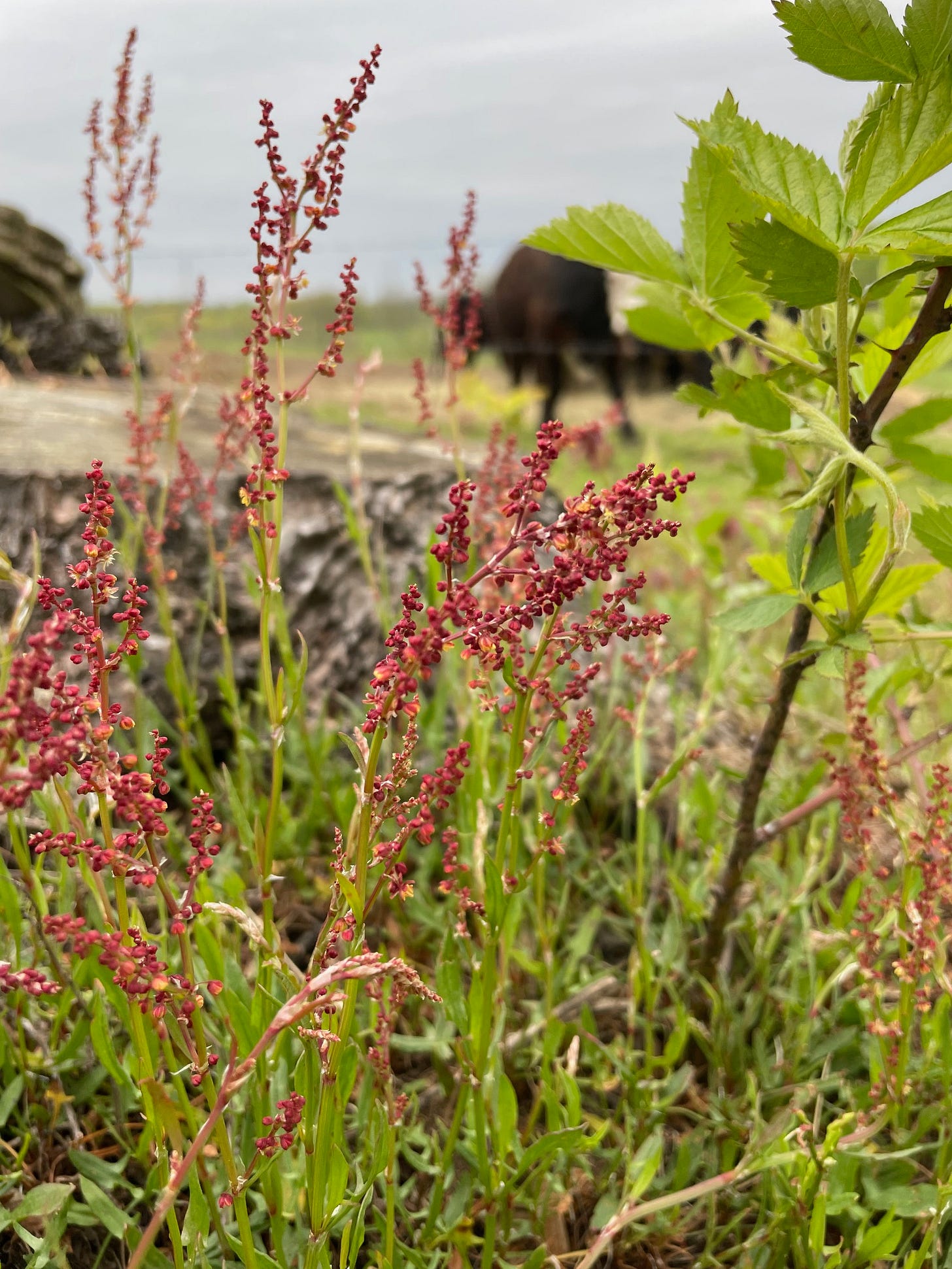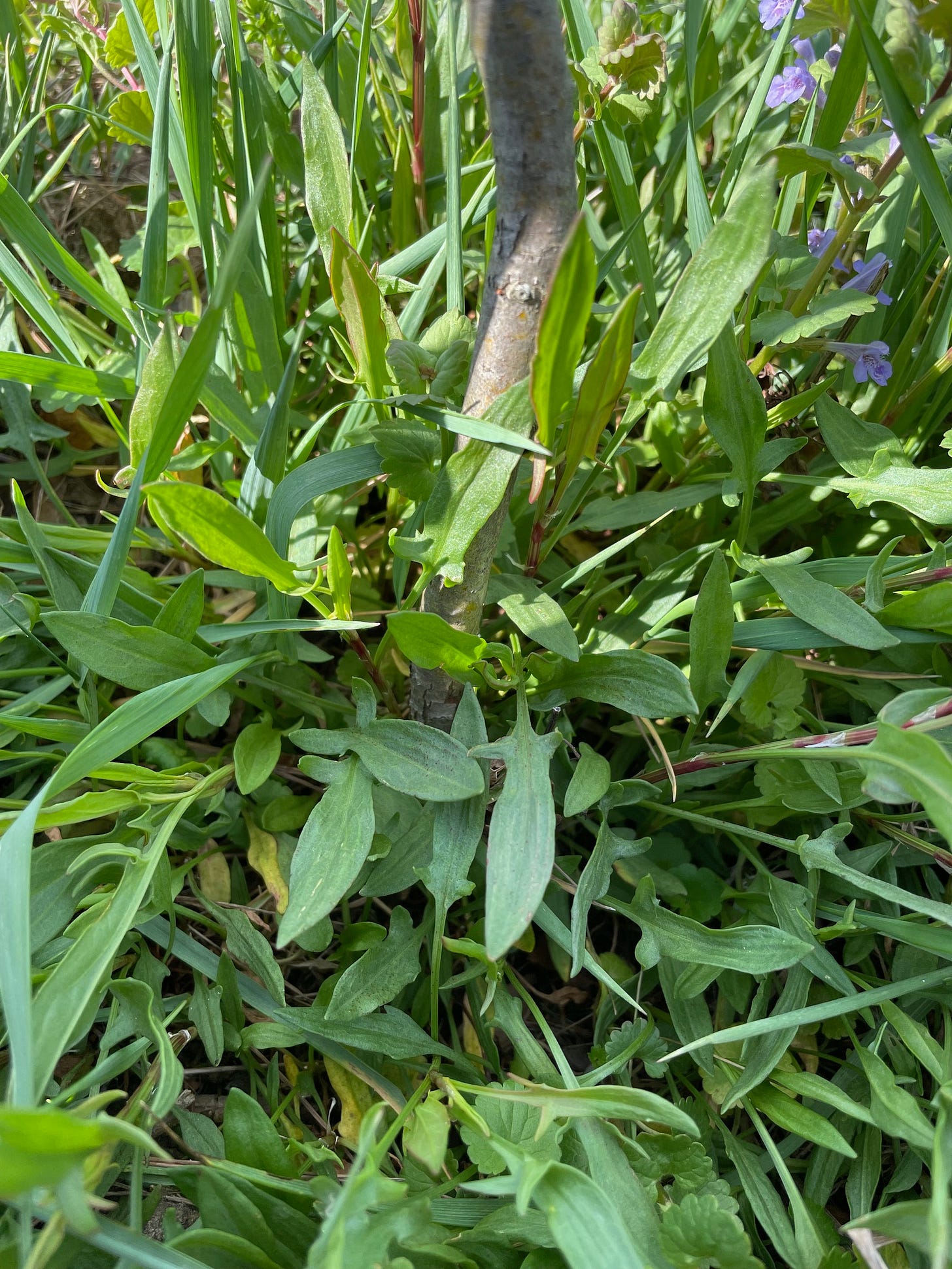This unassuming little weed, known formally as Rumex acetosella, is part of a legendary alternative cancer remedy, Essiac Tea, which was widely circulated thoughout the world of herbal medicine. As expected, neither sheep sorrel nor Essiac tea have the imprimatur of any parts of the institutional health establishment or agencies.
Sheep sorrel itself, for most people is safe to eat as food in normal human proportions, and it claims more culinary devotees than the related yellow dock, Rumex crispus (our herb of last week), or most other members of this genus. Sheep sorrel is a very sour herb, owing to various acidic constituents including ascorbic acid and oxalic acid. It also bears many of the same medicinal constituents and qualities as yellow dock. This tart weed has uses as a pot herb, in soups, and as garnish or flavoring for seafood and numerous other entrees which are enhanced by an acidic or lemony bite.
When you look up herbs online now, it pays to go directly to the scientific literature and to schools of herbalism. Otherwise you might be stopped in your tracks by proclamations such as this quote from Memorial Sloan Kettering Cancer Center website :
“There is no evidence that sheep sorrel can treat diarrhea, cancer, or any other medical condition.”
NO evidence!! for ANY medical condition!! This extremist blast, insisting that sheep sorrel is good for absolutely nothing medical, might be due to its inclusion in the Essiac herbal remedy traditionally used to treat cancer patients. Medical oncology is likely hurting from the fact that so much of chemotherapy is downright unpleasant, with bankrupting high costs, and with increasingly uncertain availability. This triple bummer can cause some people to opt out of chemo altogether, and, with nowhere else to go, to reasonably seek comfort in herbal medicine and nutrition. Incidentally, Memorial Sloan Kettering labs undertook study of the Essiac tea in the late 50s and again in the mid 70s but were ‘unable’ to coordinate such things as materials handling in such a manner as to be able to reach any conclusions from data that pointed to biological activity. (For example, according to letters from Nurse Caisse, they were not using the whole sheep sorrel plant, including roots).
In more rational times, conclusions from studies in mice showing that that those receiving Essiac mixture exhibited more necrosis of implanted tumor cells than controls, would be considered a call for further investigation, rather than ‘No evidence’. Cases and claims of humans showing slowed or halted tumor growth would inspire continued studies.
The short story of Essiac Tea is that a Canadian nurse, Rene Caisse learned the recipe from an elderly female patient who had been cured of what had been diagnosed as breast cancer. This patient had opted against surgery, and instead had utilized an herbal remedy that had been offered to her by Ojibway Indians. They had taught her the ingredients so that she could continue making and taking the remedy long term. Nurse Caisse recorded what her patient told her about the herbs, and set it aside until her own aunt was faced with diagnosis of cancer that was beyond treatment. With permission from this aunt and her doctor, she mixed up the Ojibway remedy and began treatment. Her aunt showed signs of recovery within a couple of months, and in apparent remission, lived for another 20 years. Rene Caisse continued her day job as a nurse, and assumed a second job of mixing and distributing her Essiac tea remedy to anyone who came in search of it. She endured government opposition, and threats of arrest, but with the support of some physicians and numerous patients, she continued mixing and stirring for many years. More of her story can be seen at essiacinfo dot org . (You have to manually go there because that webmaster does not want any links from any other sites for fear of legal repercussions in Canada.)
Numerous sites purport to give the recipe for Essaic tea but they’re not all in agreement. This is partly because the formula was not distributed widely by Caisse and her partners, and because she herself changed it over time. What seems to be consistent is that the burdock root is in largest proportion followed by sheep sorrel leaf, slippery elm inner bark, sheep sorrel root, and lastly a small percentage of turkey rhubarb root. Linked here is one recipe. Caisse attributed the most antitumor activity to the sheep sorrel, roots and leaves, and considered the others to be tonic and /or immune supportive. Her essaic tea was not claimed to be a cure-all for cancer but rather generally helpful to the mostly terminal patients who came her way out of desperation. Some of these patients did seem to achieve very long term remission, however.
It’s still possible to purchase the Essiac tea combination containing the following ingredients:
burdock root (Arctium lappa), which contains among others, the tumor suppressing, lignan compounds arctiin and arctigenin
sheep sorrel root and leaves (Rumex acetosella), a source of anthraquinones with antitumor activity
slippery elm (Ulmus fulva or Ulmus rubra) inner bark, a demulcent and supportive herb.
Indian or Turkey rhubarb root (Rheum officinale or Rheum palmatum), a more concentrated source of anthraquinones.
People can also obtain a second variation called “Flor Essence” later attributed to Rene Caisse and her partner Dr. Charles Brusch , containing the original (above) 4 herbs plus
kelp, Laminaria digitata,
red clover, Trifolium pratense,
watercress, Nasturtium officinale, and
blessed thistle, Cnicus benedictus.
These herbal combos are described as tonics and nutritional supplements to support general health, and bear no curative claims, in order to be allowed on the market. There’s also a burgeoning market of Essiac type herbal combinations for dogs.
Numerous health sites state that Essiac tea has been found to promote breast cancer. This is a complicated story. The main issue is with Flor Essence which contains red clover, that seems to promote estrogen dependent tumors in a specific rat model. Lower concentrations of both Flor Essence and Essiac tea could promote such tumors in vitro, but in high concentrations they were observed to be inhibitory. Plants have a lot of stuff in them, and red clover, sheep sorrel and burdock do contain phytoestrogenic compounds, So, people with estrogen hormone sensitive breast cancer …. forget about either of these 2 teas. Some in vitro tests don’t translate to in vivo models. Flor Essence stimulated Her2/neu breast cancer cells in vitro, but this did not translate to the corresponding mouse model, in which the tea showed no effect. The variety of the effects on in vitro cancer cells is also concentration dependent, with lower concentrations sometimes stimulating, and higher concentrations inhibiting the tumor growth.
Of interest is the increased early weight seen in rodents who were exposed to the Flor Essence in utero. This matches effects seen with in utero exposure to a variety of compounds such as resveratrol, bisphenol, estriol, known to have estrogenic activity.
Nurse Caisse’s recipes varied, and most of them remain a mystery. It makes sense that she saw a variety of effects in multitudinous different patients with various tumor types. To be sure, the many successes and even remissions in the Essiac story also include the wondrously healing ‘placebo effect’ conferred by this nurse who took no money for her efforts, and believed in the efficacy of her teas. A benevolent caregiver brings powerful ‘placebo effect’ which is fully legitimate, is responsible for a very large proportion of medical success, and this should be supported. It’s also very likely that with the teas, her patients were getting a beneficial tonic, improved nutrition, and care which helped them to fight their maladies.
Whether or not you are a devotee of the famous Essiac teas, Sheep sorrel itself is yummy, and a great addition to your compendium of wild edibles. Look down low for this little weed.
Though it’s believed to have origins in Europe and Eurasia, Sheep sorrel grows all over the U.S. in acidic soils (< pH 6) in disturbed areas, though it favors USDA hardiness zones 4a -8b. At weedom this herb shows up in special profusion at the edges of pine woods or around their stumps. Blueberry farmers are likely best buddies with this weed :-D The flowering tops reach about 18 inches in height, arising from a small rosette that may be 4 to 8 inches in diameter. Older leaves have a peculiar arrow shape with two ears or wings at the base, and range from 1 inch, (2.5 cm.) to 3 inches, (10 cm.) in length. (Young leaves may be oval in shape. ) Some say the smooth leaf looks like a sheep’s head viewed from the top, with the ears.
The female flower has 5 or 6 sepals only, no petals, a superior ovary, and develops an almost blood red color. Male flowers are lighter, green to yellowish in color with 6 stamens. These tiny flowers occur on racemes atop thin stems arising from the floret. The plant is dioecious, with male and female flowers on separate plants. Triangular (in cross section) shaped seeds are produced. Like yellow dock, though much smaller, the ridged, flowering stem has knobby leaf nodes with tiny papery sheaths. This is a perennial plant which spreads by rhizomes and prolifically by seed. Check here for close ups of flowers and seeds. This plant might be confused with garden sorrel, Rumex acetosa, though the leaf shape is distinctively different, and R. acetosella is a good deal smaller. This little weed has variable ploidy, (#s of chromosome sets), and morphology which will keep botanists arguing about subgenus, species and varieties until we’re all dead. They seem to hate it as an invasive, so let’s just make good use of it.
This edible plant should be cooked if you eat it in quantitiy, to reduce oxalic acid, but small amounts can spice up a salad. It’s a gentle laxative which is high in antioxidants including vitamin C. It has been used medicinally as a diuretic, diaphoretic, antiscorbutic (prevents scurvy), anti-diabetic, and to address constipation. It can be dried and used as a lemony herb for fish and anything else that is enhanced by an acidic zing. The juice of this herb could be used to curdle milk for cheese making, and incidentally, acidified thickened milk is what bears the name “buttermilk”. If you’ve ever seen a recipe for garden sorrel soup, try this weed. Add it to potato soup. Put it in a sauce for your salmon. Many herbs have tannins which help in pickling cucumbers to keep them firm. Sheep sorrel is one of them. Think of adding it to a summer tea in place of the lemon. And tell us what you’re doing with your sheep sorrel!!
Where We Dig
1. Alkushi AG. Protective Effect of Sorrel Extract on Adult Rats Treated by Carbon Tetrachloride. Pharmacognosy Res. 2017;9(2):200-207. doi:10.4103/0974-8490.204653
2. Bello OM, Fasinu PS, Bello OE, et al. Wild vegetable Rumex acetosa Linn.: Its ethnobotany, pharmacology and phytochemistry – A review. South African Journal of Botany. 2019;125:149-160. doi:10.1016/j.sajb.2019.04.018
3. Bennett LM, Montgomery JL, Collins NK, Steinberg SM, Kulp KS. Flor-Essence® herbal tonic does not inhibit estrogen receptor negative mammary tumor development in a transgenic mouse model. J Complement Integr Med. 2011;8:10.2202/1553-3840.1157.
4. Bennett LM, Montgomery JL, Collins NK, Steinberg SM, Kulp KS. Herbal tonic does not inhibit estrogen receptor negative mammary tumor development in a transgenic mouse model. J Complement Integr Med. 2011;8. doi:10.2202/1553-3840.1157
5. Bennett LM, Montgomery JL, Steinberg SM, Kulp KS. Flor-Essence herbal tonic does not inhibit mammary tumor development in Sprague Dawley rats. Breast Cancer Res Treat. 2004;88(1):87-93. doi:10.1007/s10549-004-1203-5
6. Bergo A. Sheep Sorrel (Sour Grass). Forager | Chef. Published June 30, 2023. Accessed April 23, 2024. https://foragerchef.com/sheep-sorrel/
7. Clements DR. Rumex acetosella (sheep’s sorrel). CABI Compendium. 2013;CABI Compendium:48056. doi:10.1079/cabicompendium.48056
8. Irtegün Kandemir S, Aktepe N, Baran A, et al. Determination of chemical composition and antioxidant, cytotoxic, antimicrobial, and enzyme inhibition activities of Rumex acetosella L. plant extract. Chem Pap. Published online April 9, 2024. doi:10.1007/s11696-024-03419-0
9. Kaegi E. Unconventional therapies for cancer: 1. Essiac. CMAJ. 1998;158(7):897-902.
10. Li JJ, Li YX, Li N, Zhu HT, Wang D, Zhang YJ. The genus Rumex (Polygonaceae): an ethnobotanical, phytochemical and pharmacological review. Nat Prod Bioprospect. 2022;12(1):21. doi:10.1007/s13659-022-00346-z
11. Özenver N, Güvenalp Z, Kuruüzüm-Uz A, Demirezer LÖ. Inhibitory potential on key enzymes relevant to type II diabetes mellitus and antioxidant properties of the various extracts and phytochemical constituents from Rumex acetosella L. J Food Biochem. Published online August 3, 2020:e13415. doi:10.1111/jfbc.13415
12. Zick SM, Sen A, Feng Y, Green J, Olatunde S, Boon H. Trial of Essiac to ascertain its effect in women with breast cancer (TEA-BC). J Altern Complement Med. 2006;12(10):971-980. doi:10.1089/acm.2006.12.971
13. Hype or Fact? Essiac Tea Fights Cancer. Dr. Axe. Accessed April 23, 2024. https://draxe.com/nutrition/essiac-tea/
14. Rumex acetosella (Field Sorrel, Red Sorrel, Sangre de Toro, Sheep Sorrel, Sour Weed) | North Carolina Extension Gardener Plant Toolbox. Accessed April 23, 2024. https://plants.ces.ncsu.edu/plants/rumex-acetosella/
15. Sheep Sorrel: Pictures, Flowers, Leaves & Identification | Rumex acetosella. Accessed April 23, 2024. https://www.ediblewildfood.com/sheep-sorrel.aspx
16. Sheep Sorrel | Memorial Sloan Kettering Cancer Center. Published February 24, 2022. Accessed April 23, 2024. https://www.mskcc.org/cancer-care/integrative-medicine/herbs/sheep-sorrel
17. Sheep’s Sorrel: Medicinal Uses, Identification And How To Cook With It | ForagingGuru. Published July 15, 2022. Accessed April 23, 2024. https://foragingguru.com/sheeps-sorrel/
18. Sheep Sorrel – Rumex Acetosella: Edible & Medicinal Uses of the Sour Spinach of Wild Plants - Song of the Woods. Published September 2, 2022. Accessed April 24, 2024. https://www.songofthewoods.com/sheep-sorrel-rumex-acetosella/









Thank you for this info.
The link for the tea should be https://essiacinfo dot org.
The a and i were out of order.
"“There is no evidence that sheep sorrel can treat diarrhea, cancer, or any other medical condition.”"
Dr Zelenko provided us with "their" definition of "no evidence" and the "how" and the "why" of "it"
The proven criminal Big Pharma works a bu-sin-ess model of criminal activity undertaken for big money takings until stopped and fined, a relatively small cost in their bu-sin-ess model.
In furtherance of its criminal activities it conducts a war on generic drugs and nutraceuticals facilitated with its "capture" of the fda, cdc, nih and niaid. note: the fauci niaid is also taken over by the bioweapon/bioweapon countermeasure aspect of the military / industrial / bioweapon/bioweapon countermeasure / pharma / academic / media "complex".
In the run up to the pandemic the criminal big pharma completed its "capture" with its policy insertion into the fda, cdc, nih and niaid stating ~ that the only acceptable "evidence" allowed to be deemed "evidence" would be that from the large randomized, double blind, placebo control trial - "their" easily manipulated "gold standard".
So, on March, 23 2020 when Dr. Vladimir (Zev) Zelenko sent his letter "To all medical professionals around the world:" detailing REAL WORLD EVIDENCE showing that early outpatient treatment stopped covid caused hospitalization and death for those at highest risk from covid, i.e. those people in the age and co-morbidity categories who were being hospitalized for covid and who died from covid, the evil et al. proclaimed there was "no evidence" and began its attack.
from Dr Zelenko's letter which spelled out his covid treatment protocol and the following showing the results of treating People, at high risk of hospitalization and death, who came asking for help ... "Of this group and the information provided to me by affiliated medical teams, we have had ZERO deaths, ZERO hospitalizations, and ZERO intubations. In addition, I have not heard of any negative side effects other than approximately 10% of patients with temporary nausea and diarrhea.
In sum, my urgent recommendation is to initiate treatment in the outpatient setting as soon as possible in accordance with the above. Based on my direct experience, it prevents acute respiratory distress syndrome (ARDS), prevents the need for hospitalization and saves lives.
With much respect,
Dr. Zev Zelenko
cc: President Donald J. Trump; Mr. Mark Meadows, Chief of Staff"
All REAL WORLD EVIDENCE showing safety and effectiveness of generic medicine covid treatment protocols used by Real Doctors practicing Real Medicine treating Real Patients, now, by policy, declared to be "no evidence" by the fda, cdc, nih and niaid. A lie to insure Real early treatment and all Real treatment for covid could be and was intensely suppressed, banned, and viciously punished which resulted in the knowing Depraved-heart Mass Murder of Millions. Millions Murdered for the purpose of insuring "there are no adequate, approved, and available alternatives" a FDA requirement for granting an emergency use authorization for, the big bucks for criminal big pharma and captured "government" agency's, so called "safe and effective" genetic manipulation, fast cheep and dirty - manufactured dirty covid "vaccinations" as well as to "salt the big bucks battlefield" with FEAR FEAR FEAR to program the minds of the people to line up to be injected over and over and condemn those who had gained and kept the common sense to SAY NO!.
All figured out and revealed by Dr Zelenko shortly after his, Truely, safe and effective covid treatment was viciously attacked and banned.
see definition of Depraved-heart murder at wickedpedia here https://en.wikipedia.org/wiki/Depraved-heart_murder